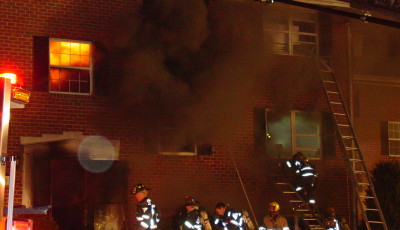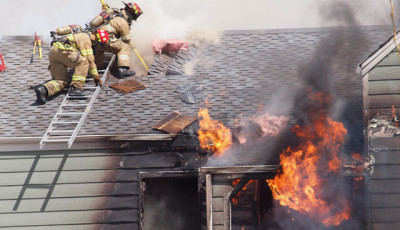The Eng.’s Primary Mission: Initial Line Placement
Basic Tactical Considerations
Once the appropriate size attack line has been selected the next decision is where to place the critical initial attack line. Keep in mind that the initial attack line stretched at a structure fire is the key to saving lives, the decision on where to place this line should be based on the need to protect the building occupants from the advancing fire and smoke conditions.
Traditional fire ground tactics suggest that fire attack is made from the unburned to the burned side of the fire. The problem with this theory is it does not factor in civilian or firefighter safety. It is based solely on an old and outdated understanding of fog stream tactics and the concern that if used inappropriately the fire could be pushed into uninvolved areas of a structure.

The initial attack line stretched at a structure fire is the key to saving lives. Photo Courtesy: Bryan T Smith
Size Up Considerations For Initial Attack Line Placement
1. Type of Occupancy
2. Location of the Fire, attic, basement, front or rear
3. Extent or Size of the Fire, one room or fully involved
4. Access and Egress to building
5. Location of stairs
6. Order of Arrival, 1st due fire attack, 2nd due back-up
7. Mode of Attack, offense interior, defense exterior
8. Where are we operating, Fire building or Exposure
Consider a scenario where an engine arrives to find fire on the 1st floor front living room of a 2 story private dwelling with people trapped above the fire. If we attacked the fire from the unburned side we would need to stretch around to the rear and work our way through the structure to fight the fire, which is both impractical and unnecessary.
The extra time, hose and man power it would take to get the line around to the rear would create a delay in getting water to the seat of the fire allowing the fire to grow and extend all the while decreasing the survivability chances of the trapped occupants.
Attacking this fire from the front not only allows us to reach the seat of the fire quicker but since most stairways in residential structures are found just inside the front door it allows us to quickly place the line at the base of the stairs. Our aggressive attack is performed quicker and from a position that will drive heat, smoke and flames away from the primary means of egress. This also creates a safe path of travel for firefighters moving upstairs to conduct a search as well as provide an additional measure of safety having a charged line below them in case the fire lights back-up.
Basement Fire Line Placement
For basement fires the objective of protecting the means of egress and quickly extinguishing the fire is the same, but depending on the extent of the fire and type of construction our tactics may be different.
For advanced fire conditions in a basement it may not be safe to send the initial line through the 1st floor (above the fire). It may be a safer decision to stretch the initial attack line to the exterior basement entrance to quickly knock the fire. Then you can have the 2nd line advance through the interior to the top of the basement stairs. If the fire is relatively small or confined to a small area in the basement then you can advance the initial line through the first floor to the top of the basement stairs. The second line should be stretched to the exterior basement entrance and advanced to the seat of the fire.
Although our primary objective is to quickly reach and extinguish the fire, we should always make our advance from a position that allows us to cut off or limit extension to areas of a structure were people may be trapped.
Until next time, “Be safe. Be ready.”











